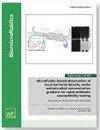微流体盖将标准 96 孔板转换为质量传输控制免疫测定系统
IF 2.6
4区 工程技术
Q2 BIOCHEMICAL RESEARCH METHODS
引用次数: 0
摘要
96 孔微孔板广泛用于免疫测定,但由于缺乏分析物迁移控制,它面临着测定时间长、灵敏度有限等挑战。通常用于促进质量传输的轨道振动器只能提供有限的改进,并可能导致测定结果不一致。微流控装置虽然能提高性能,但其复杂性和与现有平台的不兼容性限制了其广泛应用。本研究介绍了一种新型微流体 96 孔盖,旨在将标准 96 孔板转换为质量传输控制表面生物反应器。孔盖采用微流体方法提高分析物向固定在孔底的受体的扩散通量。模拟和实验结果表明,盖板能显著提高分析分子的捕获率,从而提高各种检测方法的信号强度并降低检测限。该盖板可作为标准 96 孔板的有效附加组件,在无需修改现有基础设施或试剂的情况下提高检测性能。这项创新有望提高基于微孔板的免疫测定的效率和可靠性。本文章由计算机程序翻译,如有差异,请以英文原文为准。
A microfluidic cover converts a standard 96-well plate into a mass-transport-controlled immunoassay system
96-well microtiter plates, widely used in immunoassays, face challenges such as prolonged assay time and limited sensitivity due to the lack of analyte transport control. Orbital shakers, commonly employed to facilitate mass transport, offer limited improvements and can introduce assay inconsistencies. While microfluidic devices offer performance enhancements, their complexity and incompatibility with existing platforms limit their wide adoption. This study introduces a novel microfluidic 96-well cover designed to convert a standard 96-well plate to a mass-transport-controlled surface bioreactor. The cover employs microfluidic methods to enhance the diffusion flux of analytes toward the receptors immobilized on the well bottom. Both simulation and experimental results demonstrated that the cover significantly enhances the capture rate of analyte molecules, resulting in increased signal strength for various detection methods and a lower detection limit. The cover serves as an effective add-on to standard 96-well plates, offering enhanced assay performance without requiring modifications to existing infrastructure or reagents. This innovation holds promise for improving the efficiency and reliability of microtiter plate based immunoassays.
求助全文
通过发布文献求助,成功后即可免费获取论文全文。
去求助
来源期刊

Biomicrofluidics
生物-纳米科技
CiteScore
5.80
自引率
3.10%
发文量
68
审稿时长
1.3 months
期刊介绍:
Biomicrofluidics (BMF) is an online-only journal published by AIP Publishing to rapidly disseminate research in fundamental physicochemical mechanisms associated with microfluidic and nanofluidic phenomena. BMF also publishes research in unique microfluidic and nanofluidic techniques for diagnostic, medical, biological, pharmaceutical, environmental, and chemical applications.
BMF offers quick publication, multimedia capability, and worldwide circulation among academic, national, and industrial laboratories. With a primary focus on high-quality original research articles, BMF also organizes special sections that help explain and define specific challenges unique to the interdisciplinary field of biomicrofluidics.
Microfluidic and nanofluidic actuation (electrokinetics, acoustofluidics, optofluidics, capillary)
Liquid Biopsy (microRNA profiling, circulating tumor cell isolation, exosome isolation, circulating tumor DNA quantification)
Cell sorting, manipulation, and transfection (di/electrophoresis, magnetic beads, optical traps, electroporation)
Molecular Separation and Concentration (isotachophoresis, concentration polarization, di/electrophoresis, magnetic beads, nanoparticles)
Cell culture and analysis(single cell assays, stimuli response, stem cell transfection)
Genomic and proteomic analysis (rapid gene sequencing, DNA/protein/carbohydrate arrays)
Biosensors (immuno-assay, nucleic acid fluorescent assay, colorimetric assay, enzyme amplification, plasmonic and Raman nano-reporter, molecular beacon, FRET, aptamer, nanopore, optical fibers)
Biophysical transport and characterization (DNA, single protein, ion channel and membrane dynamics, cell motility and communication mechanisms, electrophysiology, patch clamping). Etc...
 求助内容:
求助内容: 应助结果提醒方式:
应助结果提醒方式:


